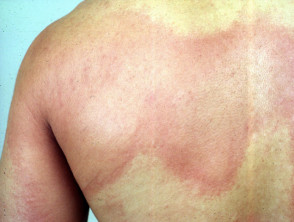What is anaphylaxis?
Anaphylaxis is a severe and rapidly developing systemic hypersensitivity reaction that is associated with the skin rash, urticaria.
Full-blown anaphylaxis includes urticaria and angioedema with hypotension and bronchospasm.
How does anaphylaxis arise?
The World Allergy Organization has categorised anaphylaxis into three groups.
- Interaction of an allergen (see causes below) with specific immunoglobulin E (IgE) or non-IgE antibodies bound to mast cells in the skin and lungs and basophils in the blood. The mast cell releases chemicals that act on blood vessels to produce a wide range of clinical effects throughout the body.
- Anaphylactoid reactions are clinically similar, but they are non-immunologically mediated.
- Idiopathic anaphylaxis, in which the cause is unknown
The severity of reactions from anaphylaxis can vary from mild symptoms to sudden death. In any case, medical attention should be sought immediately and appropriate treatment given.
Urticaria
What causes anaphylaxis?
A wide variety of substances can cause anaphylaxis or anaphylactoid reactions. Approximately one-third of all cases have no known cause (idiopathic).
- Peanuts, seafood (fish and shellfish) and tree nuts (brazil nuts, almonds, hazelnuts) are the most common foods to cause allergy
- Other foods include egg, milk, wheat, soy and sesame seeds
- Food allergy is common in children and reactions can be triggered by eating, breathing in or touching the allergen
- Reactions are usually immediate and can be severe although fatalities are rare
- Penicillins are the most common medical cause of anaphylaxis
- Other antibiotics include cephalosporins, trimethoprim + sulphamethoxazole, ciprofloxacin, sulfa drugs, tetracyclines and vancomycin
- Antiseptics and disinfectants
- NSAIDs such as aspirin, naproxen, ibuprofen and diclofenac
- Anaesthetics, muscle relaxants and opioid analgesics
Insect stings
- Bees and wasps (Hymenoptera) inject an insect venom which can cause anaphylaxis
- Local swelling and urticaria are much more common than systemic anaphylaxis
Uncommon causes
- Latex rubber
- Vaccine components
- IV radiocontrast media
- Blood substitutes and perfusion solutions
What are the signs and symptoms of anaphylaxis?
Food-induced anaphylaxis often produces skin reactions and respiratory symptoms while drug- or venom-induced anaphylaxis more often produces shock. Symptoms usually occur within 5–60 minutes of contact with the allergen, but sometimes happen after several hours, or even 3–4 days later. Fast onset and rapid progression of symptoms usually indicate severe, life-threatening anaphylaxis. One or more organ systems may be involved. Typical features are described below.
Skin
- Affected in > 85% of reactions
- Pruritus (itching) either localised or general
- Urticaria (hives), red rash and angioedema (swelling)
- The skin may feel hot and flushed
Respiratory
- Affected in about 50% of reactions
- Shortness of breath, throat tightness, coughing, sneezing, wheeze
- Upper airway obstruction indicated by nasal congestion, swelling of lips or tongue, hoarseness
Heart
- Chest pains
- Rapid or irregular heartbeat
- Low blood pressure in about 30% of reactions
Gastrointestinal
- Stomach cramps
- Nausea, vomiting and diarrhoea in about 25% of reactions
Systemic
- Confusion, dizziness
- Tremor
- Collapse
How is anaphylaxis diagnosed?
Because acute anaphylaxis can be immediately life-threatening, the diagnosis must be made quickly and efficiently, often while administering initial medication. Diagnosis is essentially made based on:
- Sudden onset of typical symptoms and signs, involving at least two organ systems (hypotension, airway swelling, wheeze, urticaria)
- Development of specific symptoms after exposure to a known or likely allergen
- Exclusion of other diseases that may have similar signs and symptoms.
What is the treatment of anaphylaxis?
Acute anaphylaxis must be treated as a medical emergency with stabilisation of airway, breathing and circulation. Intramuscular adrenaline (epinephrine) 0.3–0.5 mg (0.3–0.5 mL of 1:1000 using an autoinjector or syringe) must be given immediately to adult patients with signs of shock, airway swelling, or definite difficulty in breathing. The adrenaline is repeated after 5 minutes if there has been no improvement in hypotension, airway swelling, or wheeze.
This is followed by treatment with fluid (1000 mL 0.9% sodium chloride) and oxygen. Arrange hospitalisation and continuously evaluate consciousness, airway, pulse, and blood pressure. An antihistamine, and sometimes with corticosteroid and other drugs may be given.
Adrenaline may not be necessary for the skin manifestations of anaphylaxis alone. Treatment with antihistamines may be all that is required.
Prevention is the best medicine. All those at risk of anaphylaxis should wear a Medic Alert/emergency bracelet with full details of allergies and contact details of their doctor. In some cases, a patient or caregiver should always carry an emergency kit containing self-injectable adrenaline and antihistamine tablets.
Self-injectable adrenaline
Adrenaline is available as an autoinjector, for example, EpiPen® (0.3 mg) and EpiPen® Jr (0.15 mg). They are prescribed for emergency use in people with a history of an anaphylactic reaction. If they are used, the patient should also obtain immediate medical care. The adrenaline may cause a fast or irregular heartbeat, nausea and breathing difficulties.
- The autoinjector needs to be stored away from heat and light.
- Ask your specialist to explain when you should use it.
- Learn how to use it, and practise regularly with a trainer device. Instructions for the EpiPen are on the EpiPen website.
- Form a fist around the device and pull off the cap. Place black end against the outer mid-thigh. Push down hard until a click is heard or felt and hold in place for 10 seconds. Remove the pen. Massage the injection site for a few seconds.
